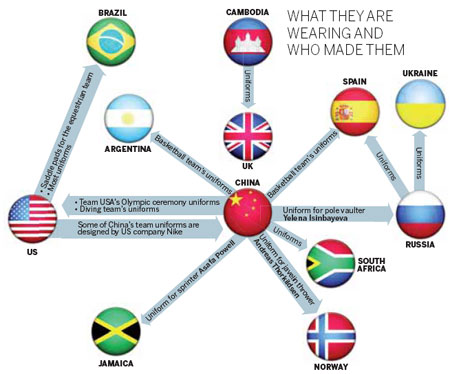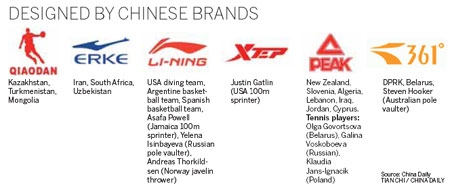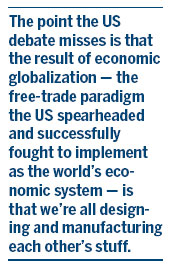Get real, we are all involved
Updated: 2012-07-29 08:25
By Erik Nilsson (China Daily)
|
|||||||||||
Politics aside, manufacturing and designing - for the Olympics, or otherwise - is now a global exercise. Erik Nilsson unravels the intricate connections.
|

 |
The revelation that Team USA's Olympic ceremony uniforms were made in China - although designed by "all-American" brand Ralph Lauren - ignited a political firestorm Stateside.
This burning anger culminated with Democratic Senate Majority Leader Harry Reid saying: "I think they should take all the uniforms, put them in a big pile and burn them, and start all over again."
In a rare moment of bipartisanship, Reid's usual archrival, Republican House Speaker John A. Boehner, said: "You think they'd know better."
The US Olympic committee's CEO Scott Blackmun responded: "With athletes having already arrived in London, and the apparel distribution process beginning this weekend, we are unfortunately not able to make a change for London."
Then American Apparel's CEO Dov Charney fanned the flames by declaring: "American Apparel could start working on uniforms today and have them in London within seven days." His offer was published 11 days before the Games.
Ralph Lauren has pledged to manufacture the 2014 Winter Games' uniforms in the US.
|
 |
But history and the realities outside the country show these flames of outrage are actually just smoke in mirrors. The real inferno is the election.
The Democratic camp hopes to highlight GOP presidential hopeful Mitt Romney's history of outsourcing and offshoring. The Republican camp, as a whole, can't afford right now to be seen as unsympathetic to the hundreds of thousands of garment workers who lost their jobs in the Great Recession.
But Romney, who has promised to "get tough on China", can't afford to say much, except: "The Olympic Games are about the athletes ... and these other matters are extraneous, I think."
The incident is also an opportunity for Democrats to remind voters that Romney, at the helm of the US committee of the 2002 Winter Olympics in Salt Lake City, outsourced the manufacture of torchbearer uniforms to "Burma".
When more than 1,000 activists e-mailed the Salt Lake Organizing Committee's media relations department, while torchbearers also publicly voiced disgust, the committee released a statement: "The torch relay clothes were NOT made in Burma. They were manufactured in Myanmar. In fact, they were made in the exact same factory that produces clothes for GAP, North Face and other major clothing labels."
When activists pointed out Burma and Myanmar are two names for the same country, the committee apologized for "misinformation". Funnily enough, the uniforms' tags were printed with: "Made in Burma (Myanmar)".
It is noteworthy that in the last Summer Olympics (2008) and in many previous Games, Team USA's uniforms were also made in China, but no uproar is as loud as in this election year.
Most of China's team uniforms are designed by the US company Nike - rather than premium domestic sportswear company Li-Ning.
The Chinese company even takes its name from the Olympic gymnastics champion who made the country proud by snapping up six medals in the first Summer Games his homeland fully joined in 1984.
The story becomes clearer, yet more complex, when you consider Li-Ning was passed over by its home country but is designing this year for the US diving team; Argentina's basketball team; Spain's basketball team; Jamaican 100m sprinter Asafa Powell; Russian pole vaulter Yelena Isinbayeva; and Norwegian javelin thrower Andreas Thorkildsen.
And if not Li-Ning, China could have gone with Peak, which is creating for seven countries - New Zealand, Slovenia, Algeria, Lebanon, Iraq, Jordan and Cyprus - and three foreign athletes. Peak has more sponsorships in London than any other company after Nike and Adidas.
There are several other Chinese companies that are creating for other countries but not their homeland, including Qiaodan, Erke, 361 and Xtep.
And there has been no discernable outcry in China - a country that has taken special pride in its Olympic legacies since it hosted the 2008 Games.
Even this year's host country has not escaped controversy. Its uniforms were made in Cambodian factories.
However, the UK debate isn't about whether producing the uniforms overseas hurts the British garment-making industry - rather, it's centered on the working conditions in the Cambodian plants.
The point the US debate misses is that the result of economic globalization - the free-trade paradigm the US spearheaded and successfully fought to implement as the world's economic system - is that we're all designing and manufacturing each other's stuff.
Custom Horse Products in the US is producing the saddle pads for the Brazilian Olympic equestrian team.
Nike is designing most of Brazil's uniforms. Russia's Bosco Sports designed Spain's and Ukraine's 2012 uniforms - and its homeland's.
American Apparel's CEO told media his company was in talks to produce Russia's 2014 gear. But the Russian Olympic committee clarified, saying that Bosco Sport is its exclusive sponsor until 2016 and manufactured this year's gear in Europe and Asia.
South Africa's uniforms are designed domestically and produced in China. When the South African Clothing and Textile Workers' Union complained, the country's Olympic committee president Gideon Sam responded by saying Erke, the Chinese producer, offered a $4 million sponsorship, which no domestic company had done.
Olympic committees, like a microcosm of our globalized world, pick who they believe is best to make what they want, and when and how they want it. They invest more thought in these practical concerns than to political borders.
Madagascar is virtually alone in designing and manufacturing its own uniforms this year.
But it's not just uniforms.
The London Games official pins are designed and manufactured by Chinese company Honav Co Ltd because of the capabilities it displayed during the Beijing Games.
China is also making almost all of the flags that will fly in London.
Kings Industrial's factory in Wuyi county, Zhejiang province, will make 40 million flags for the London Olympics.
In today's globalized world, who makes what in what country and for whom are political - but impractical - questions.
A better question might be why the Ralph Lauren Big Pony on Team USA's uniform dwarfs the US flag.
Contact the writer at erik_nilsson@chinadaily.com.cn.
Related Stories
Chinese firm makes Olympic flags 2012-07-13 09:51
Li Na out of Olympics 2012-07-28 23:53
London Olympics Day 1 2012-07-28 20:41
Yi Siling wins first gold of London Olympics 2012-07-28 18:28
Highlights of London Olympic opening ceremony 2012-07-28 10:05
Today's Top News
President Xi confident in recovery from quake
H7N9 update: 104 cases, 21 deaths
Telecom workers restore links
Coal mine blast kills 18 in Jilin
Intl scholarship puts China on the map
More bird flu patients discharged
Gold loses sheen, but still a safe bet
US 'turns blind eye to human rights'
Hot Topics
Lunar probe , China growth forecasts, Emission rules get tougher, China seen through 'colored lens', International board,
Editor's Picks

|

|

|

|

|

|





